|
|
 |
|
March 27, 2011
In my last posting about France’s Jura district, the topic was the region’s notable white wines. Now I want to point out that Jura reds should not be overlooked either. They may not be as well known among impassioned wine lovers as the whites, but they are equally unique and interesting. Because the flavor profile of Jura wines may be unfamiliar to us, they often seem strange and unfamiliar to palates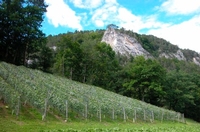 accustomed to rich, powerful, fruit driven red wine. But challenging though they can be, these wines provides a good opportunity to venture off the familiar grid of the so-called “internationally styled” red wines that so many critics grumble about in articles and blog postings. accustomed to rich, powerful, fruit driven red wine. But challenging though they can be, these wines provides a good opportunity to venture off the familiar grid of the so-called “internationally styled” red wines that so many critics grumble about in articles and blog postings.
So if you’re one of those folks who’d like to broaden your palate and get to know some wines that aren’t the same-old-same-old, the Jura is terrific place to visit--and I am referring to both the place and the wines. As my husband, Paul, and I discovered when we were there last winter, this region has a lot to offer in addition to its wines. Among the many attractions are the delicious, rustic cuisine, and the fact that the Jura lies in a scenic Alpine setting relatively untrammeled by tourists.
One of the first red wines a visitor may encounter is Poulsard, which is perhaps the oddest of Jura’s reds. Poulsard tends to be pale in color, and it often has a peculiar, almost reductive aroma, but don’t give up on it. One of the surprises of Poulsard is how tasty the good ones can be when paired the hearty regional foods. Try Poulsard with the flavorful local sausages, for example, or with any one of the various chicken dishes that are popular here.
Trousseau is a red with slightly more color than Poulsard. The most interesting versions of it can be appealingly both fruity and gamey, and they finish on a note of pronounced acidity. A reflection of the cool climate here in the foothills of the Alps, this acidity might seem jarring in some of the less-successful wines made with under-ripened fruit, but optimally, when all the elements are in balance, that zing of acidity on the finish can be exceedingly pleasant and refreshing.
Given that the Jura is positioned right next door to Burgundy, there is a fair amount of Pinot Noir here. But given, also, that the elevation is 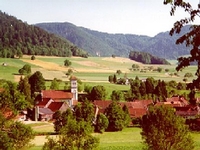 higher and the climate cooler, Pinots tend to be lighter in color and more delicate overall than their Burgundian counterparts. The best examples of Jura Pinot Noir, however, are wonderfully invigorating and complex. higher and the climate cooler, Pinots tend to be lighter in color and more delicate overall than their Burgundian counterparts. The best examples of Jura Pinot Noir, however, are wonderfully invigorating and complex.
Rosés may be made from any or all of Jura’s three red grapes. They can be quite good, at times surprisingly substantial, and they are sometimes laced with the kind of tannins more often associated with red wine. The rosés are generally called “Rubis” or “Corail” (Coral). They make good aperitifs and are often exactly the right thing to have with the robust local food.
One of the biggest surprises for me in the Jura was the high quality of the Crémants. Based mostly on Chardonnay, the good ones are knockouts--crisp, clean, bouncy sparklers with loads of personality. They can be as good as--if not better than--most crémants from any other appellation in France. They are obvious choices as an aperitif, 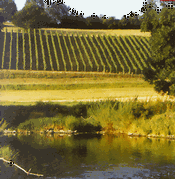 but when you want a wine to contrast with the food rather than something to echo it, crémant is often a good way to go here. but when you want a wine to contrast with the food rather than something to echo it, crémant is often a good way to go here.
During the few days we spent in the Jura we merely scratched the surface of the wine scene, but I did compile a list of some of my favorite producers (offered here in no particular order). Some of these labels are available in the U.S., but most are not--you’ll just have to go to the Jura to taste them!
Domaine Morel Thibaut, Fruitière Viticole d’Arbois, Domaine de Montbourgeau, Chateau l’Etoile, Domaine Martin Faudot, Frédéric Lornet, Domaine de la Renardière, Chateau d’Arlay, Rolet Père et Fils, Jacques Tissot, Stéphane Tissot, Henri Maire, Domaine Jean Bourdy, Domaine Berthe-Bondet, Domaine Benoit Badoz, Julien Labet, Rijckaert, Baud, Domaine Octaven, Domaine de la Tournelle, Céline et René Treuvey, Domaine Desiré Petit, Domaine de la Pinte, Domaine Daniel Dugois.
Posted by Marguerite Thomas at 10:02 AM
|
|
March 23, 2011
(Robert Whitley's Creators Syndicate Wine Talk column for this week.)
It started after I posted an innocent comment on my Facebook page about my new Riedel wine glasses.
I had just taken delivery of 1,000 Riedel Ouverture red wine glasses to replenish inventory for the multiple wine competitions we stage throughout the year in San Diego. I chose the Ouverture red wine glass a number of years ago because of its versatility.
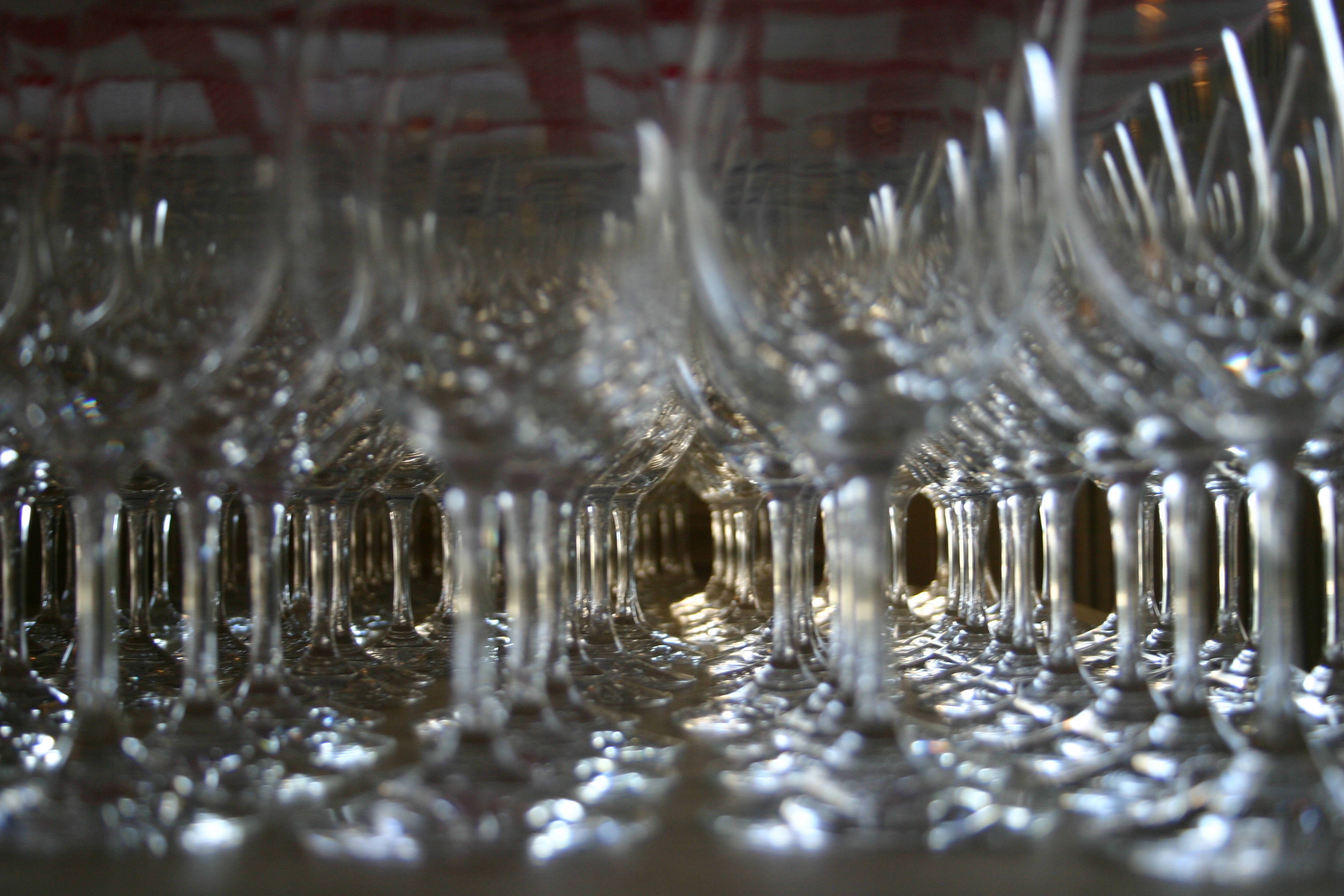 All types of wine — red, white, sparkling and dessert — are judged from this glass, which is short, with a generous girth and a narrow mouth. It has served us well. My colleague, Bob Foster, who also has run a fair number of wine competitions in his day, commented: "I like that glass. But I think the idea that each grape needs its own shape is the greatest wine scam of our era." All types of wine — red, white, sparkling and dessert — are judged from this glass, which is short, with a generous girth and a narrow mouth. It has served us well. My colleague, Bob Foster, who also has run a fair number of wine competitions in his day, commented: "I like that glass. But I think the idea that each grape needs its own shape is the greatest wine scam of our era."
Riedel, of course, is the Austrian glass manufacturer that dominates the world of stemware for wine. A number of years ago, Georg Riedel began promoting the idea of one style of stemware for red Burgundy, another for Bordeaux and yet another for Chardonnay. Now there are glasses for Syrah, Riesling, Chianti, Barolo, Sauvignon Blanc, et al — you name it Riedel makes a glass for it.
I conceded in an ensuing comment that the Riedel glass-for-grape program is a marketing gimmick. Perhaps, that was a poor characterization because a "friend" named Ron, from Houston, quickly added to the comments with this: "I disagree. To each grape, its own glass. It does make a difference in the overall ranking of a wine. Try enjoying a great red Bordeaux in a paper cup. Then try it in a Chardonnay Riedel glass followed by the proper glass. Each is a totally different experience."
I can't deny Ron's contention that a Bordeaux tasted in such a sequence would deliver a different tasting experience each time. That is precisely the reason all of the wines at any commercial wine competition are judged from the same glass. That's the one common denominator that levels the playing field and gives each wine an equal opportunity based on nothing other than its merits.
But if Ron is right, does that mean we can't properly enjoy the wines we purchase unless we have a special glass for each one?
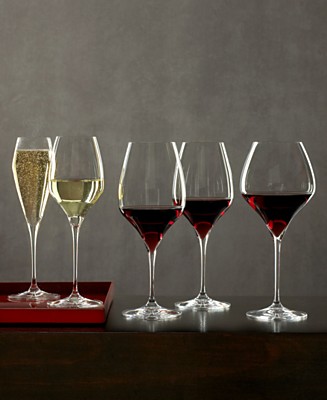 Foster responded: "Originally, Riedel claimed the shape was designed to put the wine onto the point in the tongue where the taste buds were located for that wine's flavors. But since they now know the taste buds are all over the tongue, the 'science' behind the glasses is totally gone. It IS a marketing gimmick." Foster responded: "Originally, Riedel claimed the shape was designed to put the wine onto the point in the tongue where the taste buds were located for that wine's flavors. But since they now know the taste buds are all over the tongue, the 'science' behind the glasses is totally gone. It IS a marketing gimmick."
My friend George Skorka, a sommelier from Los Angeles, chimed in: "But shape makes a difference. So ... chill."
It was an interesting but dizzying debate, for I agreed with parts of everyone's argument. So I had to ask myself how I would advise a wine enthusiast to proceed so as to arrive at a good outcome with a stemware purchase. No doubt the glass is important, particularly the shape. I love the Riedel glass-for-grape program, but I still contend its marketing 101 and a luxury most of us can't afford.
What's important to me about the shape of the glass is how well it aerates the wine I am about to drink. A Champagne flute might be the ultimate in style and elegance, but a complex vintage Champagne delivers greater pleasure if it is served in a glass with a generous bowl so it can be swirled and get air.
A tight, tannic young red wine needs a glass with plenty of room so the wine will have more surface to air contact, which helps soften the tannins and elevate aromas.
Do not drink young Bordeaux from a paper cup, please. Ron was right about that.
He was flat wrong, however, that each grape variety needs its own specially designed Riedel glass to be properly enjoyed.
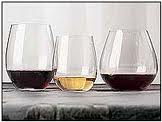 I concluded my Facebook posting with this comment: "The concept of a different glass for each grape is a gimmick because it isn't practical. A consumer needs one or two shapes in a glass and that's certainly sufficient. To tell consumers they must drink Syrah from a Syrah glass instead of a Bordeaux glass or they're somehow missing something or doing an injustice to the wine is to overcomplicate the entire wine-drinking experience." I concluded my Facebook posting with this comment: "The concept of a different glass for each grape is a gimmick because it isn't practical. A consumer needs one or two shapes in a glass and that's certainly sufficient. To tell consumers they must drink Syrah from a Syrah glass instead of a Bordeaux glass or they're somehow missing something or doing an injustice to the wine is to overcomplicate the entire wine-drinking experience."
I will stand by that final observation. The glass you choose is important and should enhance the wine experience, so buy a really good glass. But don't overthink it, or you will go broke.
To find out more about Robert Whitley and read features by other Creators Syndicate writers and cartoonists, visit the Creators Syndicate website at www.creators.com.
Posted by Robert Whitley at 11:06 AM
|
|
March 19, 2011
The 28th annual San Diego International Wine Competition is just around the corner and we're locking in the judges who made a commitment months ago to come to the Westgate Hotel in downtown San Diego, April 2-3, to help us evaluate the approximately 2000 wines entered in this year's competiton.
Selection of qualified judges is probably the most important aspect of my job as Director. We have a talented group this year, of which I am very proud. The updated list:
CHIEF JUDGE
 Michael Franz, Editor, Wine Review Online Michael Franz, Editor, Wine Review Online
JUDGES
Hans Backhoff, Winemaker, Monte Xanic, Baja, Mexico
Thrace Bromberger, Gustavo Thrace & Tool Box, Napa Valley, CA
Richard Carey, Winemaker, Vitis Research, Pennsylvania
Kimberly Charles, Charles Communications
Will Costello, Sommelier, Addison, Del Mar, CA
Etienne Cowper, Winemaker, Wilson Creek Winery, Temecula, CA
Adam Curling, Sommelier, Wynn Bartolotta, Las Vegas, NV
Thom Curry, Temecula Olive Oil, Temecula, CA
Mark Deegan, Henry Wine Group, San Diego, CA
Ken Deis, Crooked Vines, Livermore, CA
 Traci Dutton, Sommelier, Culinary Institute of America, St. Helena, CA Traci Dutton, Sommelier, Culinary Institute of America, St. Helena, CA
Bob Foster, California Grapevine, San Diego, CA
Bill Gillespie, Torrey Wines, San Diego, CA
Katherine Jarvis, Jarvis Communications, Los Angeles
Linda Jones-McKee, Wines & Vines, Pennsylvania
Heather Nenow, Winemaker, Turner Road, Lodi, CA
Vernon Kindred, Winemaker, Fallbrook Winery, Fallbrook, CA
Adam LaZarre, Winemaker, Villa San-Juliette, Paso Robles, CA
Kate McHugh, Quintessential Wines, San Diego, CA
Matt Ortman, Winemaker, Ortman Family Vineyards, San Luis Obispo, CA
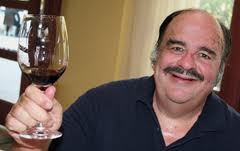 Nicholas Palumbo, Palumbo Wines, Temecula, CA Nicholas Palumbo, Palumbo Wines, Temecula, CA
Deborah Parker-Wong, Tasting Panel Magazine, San Francisco, CA
Jeremy Parzen, DO Bianchi Wine Blog
Ray Pompilio, Wegman’s Food Markets
Ron Rawlinson, Ortman Family Vineyards, San Luis Obispo, CA
Lisa Redwine, Sommelier, The Shores, La Jolla, CA
Mike Stepanovich, SWE, Bakersfield, CA
David Stevens, Senior Winemaking Consultant, Davon International, Napa Valley, CA
Jim Swelgin, Maurice Carrie, Temecula, CA
Kevin Walsh, Henry Wine Group, San Diego, CA
Duncan Williams, Winemaker, Fallbrook Winery, Fallbrook, CA
Posted by Robert Whitley at 2:49 PM
|
|
March 15, 2011
(Robert Whitley's Creators Syndicate Wine Talk column for this week.)
Family Winemakers of California is an organization of small wineries that takes to the road each year to showcase member wineries that otherwise might fly under the radar.
Many of these vintners run mom and pop operations that barely sell beyond the tasting room, while some are entrepreneurs who made it big in some other field and are now chasing the dream.
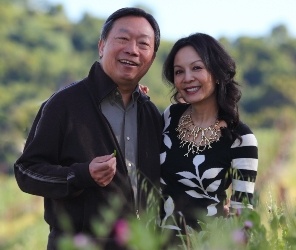 When Family Winemakers passes through my part of the world, I often have the opportunity to meet with a vintner or two and taste wines that are truly made from the heart. In fact, this was how I stumbled across the stunning wines of Sojourn Cellars, and some of the finest Pinot Noir California has to offer. When Family Winemakers passes through my part of the world, I often have the opportunity to meet with a vintner or two and taste wines that are truly made from the heart. In fact, this was how I stumbled across the stunning wines of Sojourn Cellars, and some of the finest Pinot Noir California has to offer.
That was last year. This year's discovery is the miniscule Hestan Vineyards of the Napa Valley, which produces between 4,000 and 5,000 cases of wine a year — all made at the Laird custom-crush facility by the winemakers Mark Herold and Jeff Gaffner.
The production is predominantly red, with grapes coming from 40-plus acres located in the rolling hills of southern Napa Valley. The property is planted to the five traditional Bordeaux grape varieties: Cabernet Sauvignon, Cabernet Franc, Malbec, Petit Verdot and Merlot.
The winery is owned by Helen and Stanley Cheng, who have made a fortune selling pots and pans such as Farberware, Circulon, et al. They had been very involved with Napa's Copia wine center, donating generously to Copia's food and wine program when the center first opened. The winery name is a combination of their names: He(len)Stan(ley). The produced their first vintage in 2002.
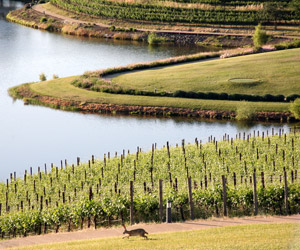 My first exposure to a Hestan wine (there are different labels under the same roof) was the 2006 Stephanie Merlot, which retails for about $35. I tasted it almost a year ago, but I chose not to review it because of limited availability. Stephanie is the Cheng's daughter, and her name graces one of the labels. Besides Hestan and Stephanie, the other label is Meyer, which is taken from the name of the Cheng's cookware company. My first exposure to a Hestan wine (there are different labels under the same roof) was the 2006 Stephanie Merlot, which retails for about $35. I tasted it almost a year ago, but I chose not to review it because of limited availability. Stephanie is the Cheng's daughter, and her name graces one of the labels. Besides Hestan and Stephanie, the other label is Meyer, which is taken from the name of the Cheng's cookware company.
The 2006 Stephanie Merlot struck me as one of the most impressive Merlots I had tasted in more than 20 years of evaluating Napa Valley wines professionally. Naturally, I wanted to know more about the wines of Hestan when the Family Winemakers made their rounds this year.
When I went through the entire lineup of the six wines presented, I found the 2007 Stephanie Merlot (94 points) to be every bit as memorable as the 2006. At the price, it is certainly one of the great wine steals of the Napa Valley. The wine that bowled me over, however, was the 2007 Stephanie Proprietary Red Wine ($60).
 Probably best known for his own label, Saxon Brown, Gaffner made the Stephanie wines. Probably best known for his own label, Saxon Brown, Gaffner made the Stephanie wines.
He's a brilliant winemaker based in Sonoma, and he's the man behind the Black Kite Pinot Noirs of Anderson Valley, which to my palate are as good as any Pinots made in the New World. Gaffner also worked under the legendary winemaker Dick Arrowood — together they launched the Bordeaux-style blend Cinq Cepages at Chateau St. Jean just a few decades ago.
Gaffner is well grounded in Bordeaux blends. The Stephanie Proprietary Red Wine (97 points) uses all five of the traditional Bordeaux grape varieties, but the emphasis in the 2007 is on Cabernet Sauvignon and Petit Verdot. This wine is a masterpiece of balance and complexity. On the nose, it exhibits notes of cedar, spice, licorice and mocha. On the palate, the purity of fruit is stunning by revealing aromas of blueberry, black currant and blackberry in endless layers of flavor. The wine is dense and rich without being daunting, and the gentle backnote of wood smoke provides a wonderful savory accent. The wine finishes with long, persistent waves of flavor.
This is Napa Valley red wine at its finest. Though this wine is far from cheap, given the neighborhood and the extraordinary quality, it rates as a steal.
 The 2007 Stephanie Cabernet Sauvignon (94 points, $50) was another home run, though not as exotic and mind-blowing as the Proprietary Red Wine. The Cabernet offered a true Cabernet nose, which merely means there was a light herbal note that is typical of the grape variety, even when picked perfectly ripe. Aromas of cedar and spice are enticing, and on the palate, the wine delivers dark-fruited aromas and a meaty texture that is both delicious and compelling. The 2007 Stephanie Cabernet Sauvignon (94 points, $50) was another home run, though not as exotic and mind-blowing as the Proprietary Red Wine. The Cabernet offered a true Cabernet nose, which merely means there was a light herbal note that is typical of the grape variety, even when picked perfectly ripe. Aromas of cedar and spice are enticing, and on the palate, the wine delivers dark-fruited aromas and a meaty texture that is both delicious and compelling.
The Hestan 2007 Cabernet Sauvignon (95 points, $100) is the winery's flagship wine and is made to be cellared, at least long enough for the chewy tannins to integrate. This Cabernet exhibits wild, brambly berry fruit aromas, rustic tannins and complex notes of coffee, mocha and spice. In the mouth, it has the rough and tumble feel of a Napa Valley mountain cabernet, in stark contrast to the sleek style of the Stephanie wines.
The 2007 Meyer Cabernet Sauvignon (91 points, $45) is a classic Napa Valley Cab with rich dark fruit aromas, density on the palate, and persistence of flavor through the finish. It is Hestan's "volume" wine in that more than 2,000 cases are produced, which is about half of the entire Hestan production.
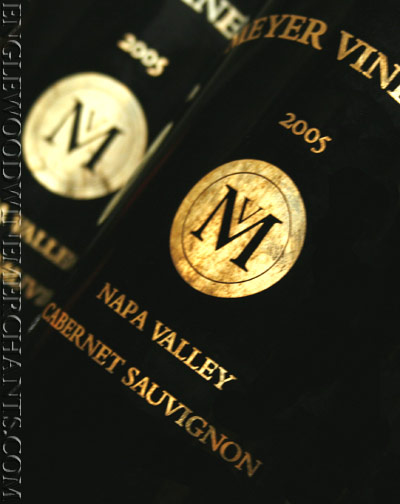 A 2008 Hestan Chardonnay (88 points, $50) will please those who enjoy rich, oily, oak saturated Chards. I found this wine more appealing when first opened. But with time, air and as it warmed, the aromas of the wood began to dominate, which some will find attractive, though it isn't my preferred style. A 2008 Hestan Chardonnay (88 points, $50) will please those who enjoy rich, oily, oak saturated Chards. I found this wine more appealing when first opened. But with time, air and as it warmed, the aromas of the wood began to dominate, which some will find attractive, though it isn't my preferred style.
The wines of Hestan are produced in such limited quantities that they will be difficult to find, but they are available directly from the winery and can be purchased on their website at www.hestan.com.
They are well worth the extra effort to source.
Posted by Robert Whitley at 12:09 PM
|
|
March 9, 2011
Both of our columns in this week’s issue are devoted to rare, ultra-expensive wines, so it seems prudent for me to point to some exceptional bargains in this space--lest you get the misimpression that WRO has deserted you in favor of the Extended Pinky set.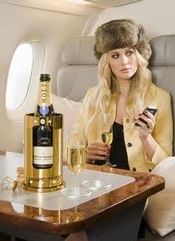
That is definitely not the case. During January and February alone, I’ve already tasted more than 2,000 wines priced under $20, with the bulk of those actually priced below $12. If you do the math, that’s a hell of a lot of wine to taste. Tackling 140 wines in an evening is not the party you might guess it to be, but it can be very interesting and rewarding when there’s a bunch of good wines in the mix.
I’ve conducted similar intensive tastings of lower-priced wines at the start of the calendar year for more than a decade now. On this basis, I’m happy to report that a diffusion of technology and expertise around the world has combined with a global shift in wine styling to produce a delightful outcome: Reasonably affordable wine is the best that it has ever been, and it continues to get better every year.
Technology diffusion has now largely run its course, and my travels indicate that wine is made largely the same way with the same equipment almost everywhere in the world. Lately it has been stylistic shifts that have been making the greater contribution to improving affordable wine, and more specifically I would credit a turn toward freshness and purity and away from oak chips or other cosmetic tricks.
Many consumers will have noticed a shift in Chardonnay fitting this description, but it is now showing up in red wines as well. This is particularly apparent with lighter reds, and less expensive renditions of Tempranillo, Sangiovese and Pinot Noir are increasingly being made with minimal oak exposure. Using oak chips or other trickery in attempts to make cheap wines ape expensive ones rarely worked anyway, and the current trend toward purity and simplicity is yielding wines that are more versatile with food while also being more coherent and natural.
I’ll have more to say in coming weeks about my favorite affordable wines from recent tastings, but here’s a case of outstanding examples to enjoy while you’re saving up for DRC or Taylor’s Scion Tawny:
WHITES:
Pinot Grigio “Prendo,” Wilhelm Walch, Vigneti delle Dolomiti, Italy, 2009 ($12, Imported by The Country Vintner): Bored with Pinot Grigio? Me too, generally, but certainly not with this rendition. Fresh fruit notes of lemon and green apple in a zesty and exceptionally refreshing wine. Italy, 2009 ($12, Imported by The Country Vintner): Bored with Pinot Grigio? Me too, generally, but certainly not with this rendition. Fresh fruit notes of lemon and green apple in a zesty and exceptionally refreshing wine.
Sauvignon Blanc, Brancott Estate, Marlborough, New Zealand, 2010 ($12, Pernod-Ricard): A remarkable bargain at $12, this is often discounted below the list price due to over-planting in Marlborough. Aromas and flavors of ripe grapefruit come to the fore, with grassy undertones and a persistent finish.
Vinho Branco Regional Alentejano, Loios, Portugal, 2009 ($12, Winebow): This is more complex and distinctive than many whites costing twice as much. It shows intriguing aromas and flavors reminiscent of white melon, dried herbs and toasted nuts.
Albariño, Burgans, Rias Baixas, Galicia, Spain, 2009 ($14, European Cellars): Many bottlings of Albariño have seemed ever more diluted and watery even as their prices have risen, but in this case, both quality and price have held steady. Scents of spring flowers and flavors of peaches and pears in a fresh but substantial wine.
Mâcon-Solutré, Domaine Trouillet, Burgundy, France, 2008 ($18, J. W. Sieg): The 2008 vintage was terrific for white Burgundy, and that includes Mâcon no less than the Côte d’Or. This is lively but layered and long-lasting, with apple fruit accented with spice and mineral notes. And it tastes like a $30 wine.
Chardonnay, Domaine Antugnac, Haute Vallée de l’Aude, France, 2009 ($12, Vintage ’59 Imports): A restrained, stylish Chardonnay from the Languedoc, this shows exceptional purity and balance, and is an object lesson in the advantages of the fresh, honest style of wine that I sought to profile in the heading of this post.
Viognier, Horton, Orange County, VA, 2009 ($16): This Virginia producer turned in a remarkable performance with this 2009 Viognier, which is one of the world’s most compelling whites in the rare instances when someone really gets it right. This lovely wine shows lightly floral aromas leading into rich, satisfying flavors of peaches and pears.
REDS:
 Pinot Noir, Jargon, California, 2009 ($11): Inexpensive Pinot was quite possibly the world’s worst wine category as recently as two years ago. That has changed, thankfully, and this is a fine case in point. It is juicy and generous, with soft but substantial fruit recalling ripe strawberries and rich red cherries. Pinot Noir, Jargon, California, 2009 ($11): Inexpensive Pinot was quite possibly the world’s worst wine category as recently as two years ago. That has changed, thankfully, and this is a fine case in point. It is juicy and generous, with soft but substantial fruit recalling ripe strawberries and rich red cherries.
Merlot “Reserve,” Angeline, Sonoma County, CA, 2009 ($12): A couple of years ago, Merlot was nearly as dreadful as Pinot in this price range, but many bottlings have improved dramatically. This winning wine shows black plum and dark berry fruit with a soft, smooth finish.
Ribera del Duero, Finca Resalso by Emilio Moro, Castilla y León, Spain, 2009 ($15, Jorge Ordoñez): Generously fruited, judiciously oaked, and beautifully balanced, this is a model of proportionality. It features scents of woodsmoke and spices accenting concentrated flavors recalling black cherries.
Red Blend “Maquis Lien,” Los Maquis, Colchagua Valley, Chile, 2007 ($18, Global Vinyard Importers): Agreed, at $18 we’re not talking about an inexpensive wine. But this was one of my two picks for WRO Wine of the Year two years back, and the new release is stunning in its class and complexity. Intricate aromas of woodsmoke and spice enhance dark berry notes and a mineral-tinged finish.
Cabernet Sauvignon “Reserva,” Santa Rita, Maipo Valley, Chile, 2008 ($12, Palm Bay International): If you want aromatic complexity and distinctive flavors in your red wine, but don’t want to pay big money to get it, there is no country on earth that can match Chile right now. This shows subtle aromas of toast and cedar leading to focused flavors of black currant and blackberry.
Posted by Michael Franz at 9:07 AM
|
|
March 8, 2011
(Robert Whitley's Creators Syndicate Wine Talk column for this week.)
Over its 18 years, the annual Monterey Wine Competition has rolled out the welcome mat for great wines the world over. The Champagne houses of Dom Perignon and Lanson, for example, have enjoyed success in the past. There was the '96 competition when the iconic Napa Valley red, Joseph Phelps Insignia, won Best of Show with its excellent 1992 vintage. Wines from Australia, Spain and Italy have made their mark as well.
 This year's storyline veered down a road less traveled. To be sure, the championship round was populated by many of the usual suspects: an $80 Cabernet from the Napa Valley, a $50 Meritage from Washington's most prestigious winery and a superb white from Spain's Penedes district. There were even wines representing New York, Missouri and New Mexico. Australia and New Zealand were in the mix, too. This year's storyline veered down a road less traveled. To be sure, the championship round was populated by many of the usual suspects: an $80 Cabernet from the Napa Valley, a $50 Meritage from Washington's most prestigious winery and a superb white from Spain's Penedes district. There were even wines representing New York, Missouri and New Mexico. Australia and New Zealand were in the mix, too.
Yet at the end of the day, the first Sunday of March 2011, it was a Pinot Noir from a vineyard less than an hour from the competition headquarters at the Salinas Valley Fairgrounds in King City, Calif., that stole the show. The Wrath 2008 San Saba Vineyard Pinot Noir ($49) broke free from a three-way tie in the final round, and was named Wine of Year in a close vote.
Wrath is a relatively young (its tasting room was only recently completed) boutique winery that sits on a 70-acre parcel 25 miles southeast of Monterey, just outside the boundary of the Santa Lucia Highlands appellation. It specializes in limited-production cool-climate Pinot Noir, Chardonnay, Syrah and Sauvignon Blanc.
The winning wine had been the subject of rave reviews by numerous wine publications, such as Wine Spectator, International Wine Review, Wine Enthusiast and Wine Review Online — all of them awarding a rating of 90-plus points.
 In the final round of voting, the Wrath Pinot faced off against a 2006 Gloria Ferrer Carneros Blanc de Blancs, ($24), winner of Best Sparkling; Stone Hill's 2010 Missouri Vignoles ($12.99), voted Best White; and Heron Hill 2008 Late Harvest Vidal ($17.99), the Best Dessert winner. In the first vote on the final four, only the Gloria Ferrer was eliminated, with the other three tied. Wrath narrowly prevailed in the runoff, providing a dramatic finish as well as an impressive winner. In the final round of voting, the Wrath Pinot faced off against a 2006 Gloria Ferrer Carneros Blanc de Blancs, ($24), winner of Best Sparkling; Stone Hill's 2010 Missouri Vignoles ($12.99), voted Best White; and Heron Hill 2008 Late Harvest Vidal ($17.99), the Best Dessert winner. In the first vote on the final four, only the Gloria Ferrer was eliminated, with the other three tied. Wrath narrowly prevailed in the runoff, providing a dramatic finish as well as an impressive winner.
Other highlights from the 18th Monterey Wine Competition:
V. Sattui of the Napa Valley was named Winery of the Year following another powerful performance. Sattui collected 24 medals overall and was the runaway winner in that category. Sattui also landed two of its wines — 2007 Mount Veeder Cabernet Sauvignon ($40) and 2009 Early Harvest Riesling ($19.75) — in the championship round. Both of those wines were awarded Platinum. Sattui also had five Gold medals in its big haul.
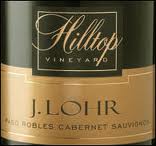 J. Lohr of Paso Robles — an important winery in California's Central Coast and long a leader in high quality wines at reasonable prices — took home 14 medals, including Platinum for the three wines it sent to the championship round: 2007 Hilltop Cabernet Sauvignon, Paso Robles ($35), 2010 Wildflower Valdiguie, Monterey ($8.50) and 2008 Los Osos Merlot, Paso Robles ($15). J. Lohr of Paso Robles — an important winery in California's Central Coast and long a leader in high quality wines at reasonable prices — took home 14 medals, including Platinum for the three wines it sent to the championship round: 2007 Hilltop Cabernet Sauvignon, Paso Robles ($35), 2010 Wildflower Valdiguie, Monterey ($8.50) and 2008 Los Osos Merlot, Paso Robles ($15).
J. Lohr also had four Gold medals.
Navarro Vineyards of Mendocino's Anderson Valley tied J. Lohr for second in the medal count, including a Platinum for its 2009 Pinot Gris, Anderson Valley ($19). Navarro also won five Gold medals for wines ranging in price from $18 to $27. This family-owned, family-run winery in the coolest area of Mendocino County specializes in aromatic whites and beautifully structured Pinot Noirs.
The Midwest was capably represented by the stellar St. James Winery of Missouri, which was the winner of 13 medals and a Best of Show award for its cherry fruit wine (winning fruit wines and grape spirits are not included in the vote for Wine of the Year). St. James won a Platinum award for its 2009 Chambourcin, Ozark Mountain ($6.99) and its non-vintage Friendship School White ($8.99).
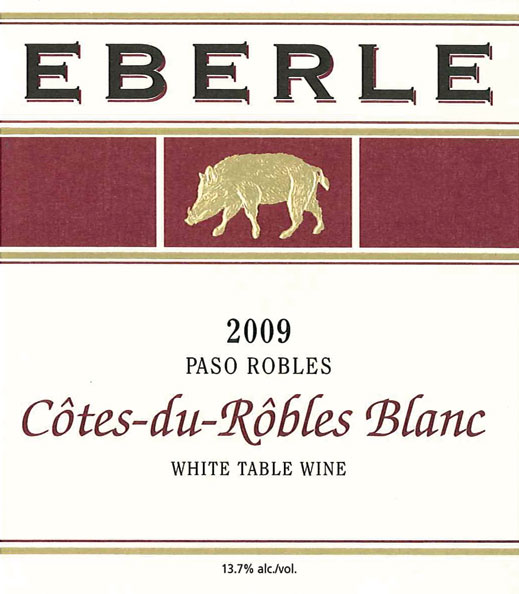 The Eberle Winery of Paso Robles hit for a high percentage by winning 10 medals on 13 wines entered, including a Platinum for its 2009 Cotes-du-Robles Blanc, Paso Robles ($24). This is a white Rhone-style blend of Viognier, Roussanne and Marsanne. Eberle also had a Gold for its 2008 Estate Cabernet Sauvignon ($34). Owner Gary Eberle was among the first winemakers to recognize the potential for grapes in Paso Robles; he planted Cabernet extensively in the early 1970s. He was also the first to introduce Syrah in the region. The Eberle Winery of Paso Robles hit for a high percentage by winning 10 medals on 13 wines entered, including a Platinum for its 2009 Cotes-du-Robles Blanc, Paso Robles ($24). This is a white Rhone-style blend of Viognier, Roussanne and Marsanne. Eberle also had a Gold for its 2008 Estate Cabernet Sauvignon ($34). Owner Gary Eberle was among the first winemakers to recognize the potential for grapes in Paso Robles; he planted Cabernet extensively in the early 1970s. He was also the first to introduce Syrah in the region.
California sparkling wine producers Gloria Ferrer and Korbel tied with eight medals apiece, but one of Korbel's medals was for its Brandy XS ($12), the Best Grape Spirit of the competition. Gloria Ferrer sent two of its bubblies to the championship round and won Best Sparkling with the 2006 Blanc de Blancs, Carneros ($24). Gloria Ferrer added three Golds to go along with its two Platinums.
For those with an eye on value, Cupcake's range of $14 wines took five medals and had two of those — 2008 Petite Sirah, Central Coast and 2010 Sauvignon Blanc, Marlborough, New Zealand — in the Platinum championship round. And Bogle came through with six medals, including two Golds, priced between $9 and $18. Bogle's Gold medals were for a Chardonnay and Sauvignon Blanc, both from the 2009 vintage and both with a retail price tag of $9.
 Small family-run wineries also had a big weekend in Monterey with Reustle-Prayer Rock Vineyard from Oregon's Umpqua Valley and Lake Chelan Winery from the Lake Chelan Valley area of Washington leading the way. Reustle-Prayer Rock won five medals, including a Platinum for its 2010 Reserve Gruner Veltliner ($26). Reustle-Prayer Rock also won two Gold medals. Lake Chelan won four medals, including Platinum medals for its 2008 Rivers Bend Vineyard Syrah, Columbia Valley ($28) and its 2008 Chardonnay Ice Wine, Columbia Valley ($30 per 375 ml bottle). Lake Chelan also had a Gold for its 2009 Sweet Riesling, Lake Chelan ($15). Small family-run wineries also had a big weekend in Monterey with Reustle-Prayer Rock Vineyard from Oregon's Umpqua Valley and Lake Chelan Winery from the Lake Chelan Valley area of Washington leading the way. Reustle-Prayer Rock won five medals, including a Platinum for its 2010 Reserve Gruner Veltliner ($26). Reustle-Prayer Rock also won two Gold medals. Lake Chelan won four medals, including Platinum medals for its 2008 Rivers Bend Vineyard Syrah, Columbia Valley ($28) and its 2008 Chardonnay Ice Wine, Columbia Valley ($30 per 375 ml bottle). Lake Chelan also had a Gold for its 2009 Sweet Riesling, Lake Chelan ($15).
Click here for complete results of the 2011 Monterey Wine Competition.
Posted by Robert Whitley at 7:33 AM
|
|
March 5, 2011
At its most basic level, the pleasure in a glass of wine depends upon the wine. Nothing you can do will make bad wine taste good. On the other hand, there are any numbers of things a person can do to make a good wine taste even better.
 No. 1: Serve wine at the correct temperature. Beaujolais, Dolcetto and other light reds are best with a slight chill. Even sturdy reds should be served relatively cool, around 65 degrees. Tannic reds served too warm can be astringent and unpleasant on the palate. It's a good idea to store your wines away from appliances, such as stoves or hot water heaters. No. 1: Serve wine at the correct temperature. Beaujolais, Dolcetto and other light reds are best with a slight chill. Even sturdy reds should be served relatively cool, around 65 degrees. Tannic reds served too warm can be astringent and unpleasant on the palate. It's a good idea to store your wines away from appliances, such as stoves or hot water heaters.
White wines and bubblies, for the most part, should be served cold. The great exception is Chardonnay, which to me is best when served cool rather than ice cold. When I order a Chardonnay or white Burgundy in a restaurant, I decline an ice bucket, unless it's a warm day and there is no air conditioning. High acid wines, such as Albarino or Gruner Veltliner, and sparkling wines will typically taste flat if served too warm.
No. 2: Choose a decent glass. I know it is custom in some parts of the world to serve wine in a water glass, but I would save that experience for cheap Valpolicella. I want a glass that is wider mid-bowl than at the mouth, so I can give my wine, red or white, a good swirl. Far from an affectation, the swirl serves to aerate the wine and bring out the aromas.
.jpg) The standard glass we use at my numerous wine competitions is the Riedel Ouverture red wine glass. It has good volume at a little more than 12 ounces, and it's versatile with all types of wine, red or white, and dishwasher safe. But virtually every department store has a broad selection of perfectly fine stemware for wine, so you should opt for whatever suits your eye and your budget. The standard glass we use at my numerous wine competitions is the Riedel Ouverture red wine glass. It has good volume at a little more than 12 ounces, and it's versatile with all types of wine, red or white, and dishwasher safe. But virtually every department store has a broad selection of perfectly fine stemware for wine, so you should opt for whatever suits your eye and your budget.
No. 3: Decant whenever practical. I decant red and white wines, primarily to aerate the younger wines, but sometimes to separate the sediment from older red wines. If you are not convinced that white wines benefit from decanting, I only ask that you try it once.
The act of decanting need not be an onerous task. While I have an array of crystal decanters at home, while traveling I've sometimes resorted to using a water pitcher. It's not fancy, but it works. In restaurants, I usually accept if they offer to decant, unless I think I might not finish the wine and plan to take the leftover home.
None of the above, however, should be construed as a substitute for choosing a good wine in the first place. What's in the glass is still the top priority.
Posted by Robert Whitley at 8:57 AM
|
|
March 2, 2011
In early March, winter’s cold breath still huffs at the windows, and the garden lies silent and bruised by frost. This is the moment when wine lovers might plan a winter getaway to Australia, or Argentina, or some other summery viticultural region in the southern hemisphere. But let me suggest another type of vinous adventure: Pack up some thermal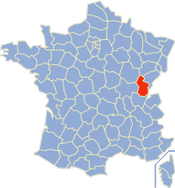 underwear, extra gloves and a pair of warm boots, and head for the Jura, France’s smallest wine region. In this pastoral land that rolls across the Alpine foothills between Burgundy and Switzerland, you’ll discover a lovely and distinctly un-touristy part of France, plus you’ll get to taste some really cool wines. underwear, extra gloves and a pair of warm boots, and head for the Jura, France’s smallest wine region. In this pastoral land that rolls across the Alpine foothills between Burgundy and Switzerland, you’ll discover a lovely and distinctly un-touristy part of France, plus you’ll get to taste some really cool wines.
You may have run into a Jura wine or two at some point in your drinking life, but if your experience is like mine was, your knowledge of them is probably pretty limited. And isn’t that one of the beauties of wine-focused travel--that you are introduced to vins, vinos, vinhos, and weins that you’d probably never encounter at home?
Last January my husband, Paul, and I flew into Geneva, picked up a rental car, and headed west towards the Jura. As we coasted down the mountain pass into France snow was falling and the air was frigid. Winters in the Jura are chillier than in Burgundy, and that extra blast of cold weather contributes distinctive searing acidity to the grapes. In the best wines those acids will be balanced by the sweetness of fruit that’s been fully ripened during the Jura’s typically long, dry, warm 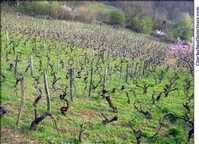 summers. And this notable equilibrium--sweetness balanced by acidity--is one of the most compelling hallmarks of good Jura wine. The best stuff is refreshingly crisp without being tart and thin, with fruit flavors that are fresh and straightforward rather than densely concentrated. summers. And this notable equilibrium--sweetness balanced by acidity--is one of the most compelling hallmarks of good Jura wine. The best stuff is refreshingly crisp without being tart and thin, with fruit flavors that are fresh and straightforward rather than densely concentrated.
Another distinctive characteristic of Jura wines is their pronounced palate-pleasing minerality, a result of the region’s fossil-rich soils composed mostly of multi-layered clay and limestone deposits, with outcroppings of marl (a sedimentary amalgam of calcium carbonate and clay). If you’re unsure what the oft used but ephemeral term “minerality” really means when applied to wine, chances are you’ll taste it in the Jura.
Most visitors who come to the Jura find the wines strikingly unfamiliar. Aside from Chardonnay and Pinot Noir, which are shared with neighboring Burgundy, the region’s grapes are unknown to most of us. The native white varietal is Savagnin (sah-vah-nee-an), while the reds are Troussau (troo-so) and Poulsard (pool-sahr). Savagnin produces the famous Vin Jaune of the Jura, a unique wine that is aged for six years in old Burgundian barrels. A space of air is deliberately left above the wine, allowing a protective film of yeast to form across its surface. 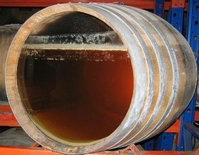 Slow oxidation occurs, permeating the wine with aromas and flavors somewhat reminiscent of sherry (but unlike sherry, Vin Jaune is not distilled). Slow oxidation occurs, permeating the wine with aromas and flavors somewhat reminiscent of sherry (but unlike sherry, Vin Jaune is not distilled).
Vin Jaune can be an utterly fascinating wine, but you have to give it a chance: To the uninitiated, its flavors can seem weird and rancid, but once your palate adjusts to that, a unique, seductive intrigue kicks in. The best wines are distinctly nutty, with hints of curry-like spices, and they can be wildly complex. Every once in awhile comes a wine makes you sit up and go “Wow!” For the cognoscenti, Vin Jaune 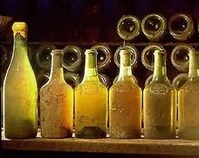 can be a truly satisfying aperitif wine (serve it with nuts and crackers), but in truth it’s tricky to find great food matches for this wine. One sure taste treat is to pair Vin Jaune with the region’s celebrated Comté cheese. can be a truly satisfying aperitif wine (serve it with nuts and crackers), but in truth it’s tricky to find great food matches for this wine. One sure taste treat is to pair Vin Jaune with the region’s celebrated Comté cheese.
Vin de Paille, the Jura’s other renowned white wine, is a rare nectar made from grapes that have dried for a minimum of 6 weeks on straw (paille, pronounced “pye”), or on wicker racks, or by hanging from rafters, until the juices are sweet and concentrated. After the grapes are pressed, the wine is aged for three years in small barrels.
Chardonnay is as indigenous a varietal here as it is next door in Burgundy, but most of Jura’s Chardonnay tends to be noticeably different from its cousin to the west. Typical Jura Chardonnay might be off-putting at first, with its jolt of sherry-like oxidation contributed by the veil (voile) of yeast that sits on top of the wine in its barrel. But one soon gets used to the unfamiliar taste and begins to appreciate the savory complexity lingering in the wine. When Chardonnay is made in more traditional fashion (without the voile) it can be markedly floral, with a layer of stony minerality, and assertive, ultra refreshing acidity. The very best Chardonnays are stupendous--Burgundian in their intensity and flavor profile. Savagnin and Chardonnay are often merged together in a savory blend which is sometimes called “Tradition” and is well worth sampling.
White wine is the calling card of the Jura, but the region also turns out distinctive reds and rosés as well as some excellent Crémants. I’ll discuss these in a future blog, and give a couple of suggestions of places to eat and stay, as well as specific labels to look for. And I’ll also tell you why winter is the best time to visit the Jura.
Posted by Marguerite Thomas at 11:04 AM
|
|
 |
|